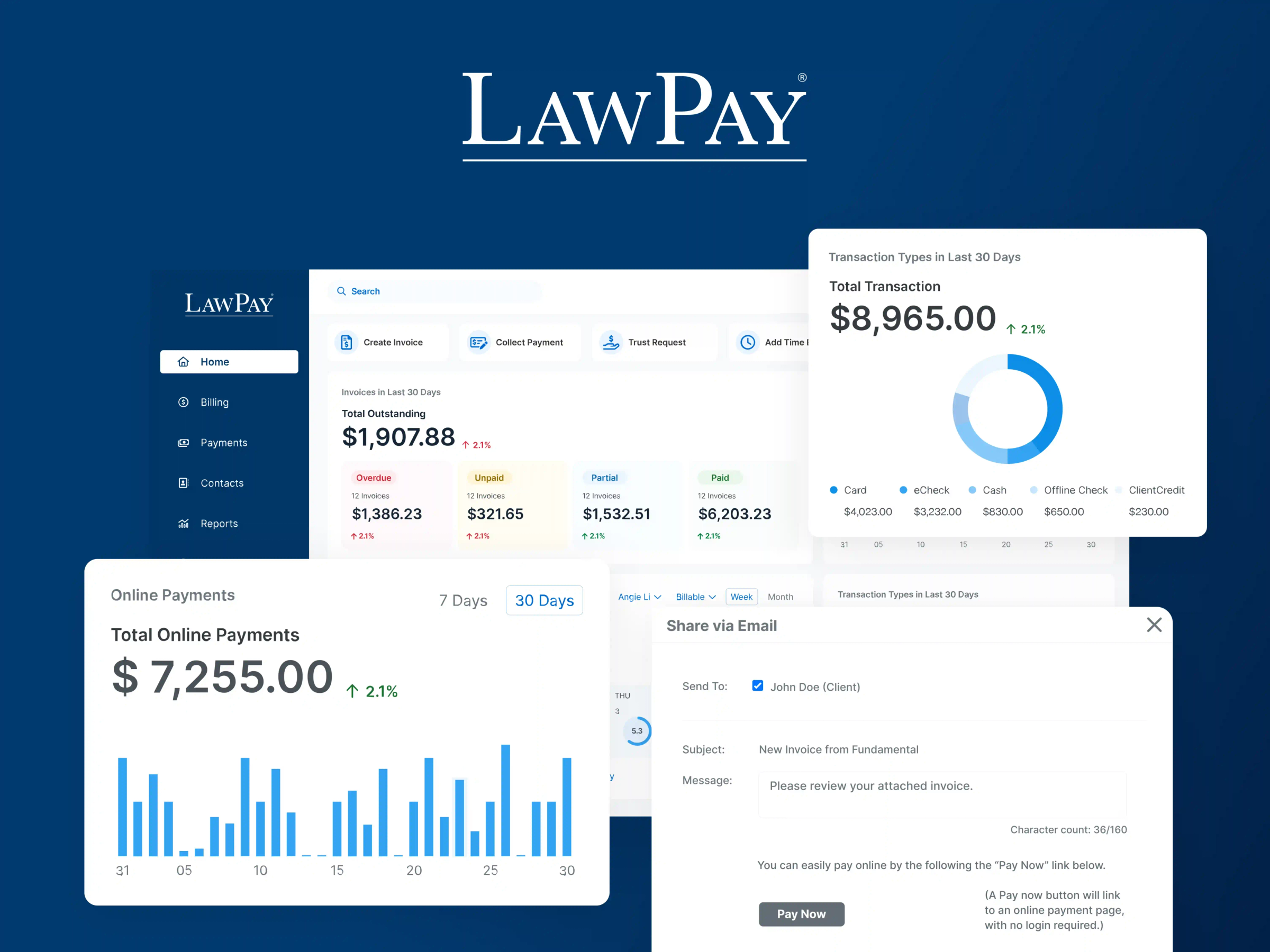Key takeaways
Law firm collection rate is the percentage of billed work that is actually collected as revenue.
It shows how effective your billing and payment process is and directly impacts cash flow and financial stability.
Tracking and improving this rate helps you keep more of what you earn and build a stronger, more predictable practice.
You’ve done the work, sent the invoice, and now you’re waiting—sometimes longer than you should. According to our 2025 Legal Industry Report, 68% of firms still struggle with fee collection.
Your law firm's collection rate is the clearest measure of how much of your billed work actually turns into revenue. When your collection rate is strong, you can keep your operations steady, reduce financial headaches, and focus on growth.
Below, we’ll discuss what a collection rate for law firms is, how to improve it, and factors that can prevent timely payments.
What is a law firm collection rate? (+ calculation)
Your collection rate indicates how much of the money you bill actually ends up in your bank account. It’s a simple way to assess your effectiveness in turning invoices into revenue. Here’s how you can calculate it:
Collection rate = (Total collected ÷ Total billed) × 100
To put this into action, if you bill $50,000 in a month and collect $45,000, your collection rate is 90%. A collection rate above 90% can be considered strong and shows healthy financial management. A rate below 85% could be a warning sign that you’re leaving a lot of revenue on the table.

How to track your law firm’s collection rate over time
Monitoring your collection rate regularly helps you spot patterns, catch problems early, and see if your changes are actually working. With a consistent system, you can turn this metric into a tool for smarter decision-making. Here’s what you could do:
Set a tracking schedule: Decide whether you’ll measure monthly, quarterly, or both. Sticking to the same schedule helps you spot trends and catch problems early.
Calculate each period’s rate: Use the formula (total collected ÷ total billed × 100) for every time period you track.
Compare against past results: Look for trends, not just one-off dips or spikes. A single late payment doesn’t mean much, but if clients are paying slower month after month, that’s a red flag for your firm’s financial health.
Review and adjust: If your collection rate drops, look at your invoicing, follow-up, and payment methods to find the cause.
Pro tip: You can also use technology to track this process automatically. Billing software or integrated payment tools can calculate your collection rate, keep records current, and even flag changes over time.
Factors that affect your collection rate
Even with a strong billing system, certain factors can drag down your collection rate. Knowing what influences payment behavior helps you adjust before it hurts your bottom line.
Key factors that impact collection rate:
Client financial strain: If clients have competing financial priorities, payments are often delayed or skipped.
Disputes over invoices: Unclear billing rates or unexpected charges can lead to pushback and late payments.
Billing clarity: If billing rates or line items aren’t clear, clients may hesitate to pay or ask for revisions.
Payment options: Limited ways to pay can add extra steps for your clients. For example, clients may need to visit the bank or spend extra time looking for their checkbook if your firm only accepts checks.
Follow-up process: Firms with no clear system for reminders or collections can see lower recovery. Without a consistent reminder schedule, clients could miss payment due dates.
Some factors are out of your control, like a client’s financial strain, but others, such as how you present your invoices, are easier to improve.
The key is to focus on what you can influence: clear billing, flexible payment options, and timely follow-ups. For the rest, it’s helpful to set realistic expectations early, use retainers when possible, and have a consistent policy for handling overdue accounts.
Tips to improve your collection rate
Improving your collection rate doesn’t mean chasing clients more—it means making it easier for them to pay you. From creating an effective legal invoice to offering flexible payment options, the right changes can reduce friction and strengthen cash flow. Here are some ways to make collections smoother and more reliable.
Make invoices clear and easy to understand
Clear invoices help clients pay without hesitation. Itemize your hours, expenses, and fees in plain terms, and avoid jargon that may confuse clients. A detailed breakdown shows clients exactly what they’re paying for and builds trust.
Use professional yet simple billing language and specific terms that explain the value of the work instead of vague descriptions. The easier it is for clients to read and understand an invoice, the faster they pay it.
Offer flexible payment options
It’s much simpler for clients to pay on time when they have convenient payment methods. Include credit and debit cards, ACH transfers, or online payment portals in your engagement letters and client intake conversations. This will set expectations early and help remove barriers to payment.
In fact, our 2025 Legal Industry Report found that 59% of firms say accepting credit and debit cards improves collection rates. Expanding to digital wallets and other modern options makes it even easier for clients to settle balances quickly, strengthening your cash flow.
Consider incorporating retainers
Lawyer retainers create a safety net by securing payment up front before rendering services. This helps reduce the risk of unpaid bills and ensures you have funds available to start work immediately.
Retainers also promote transparency since clients understand that their payment is applied toward future work, which can help reduce disputes later.
Monitor accounts receivable and follow up consistently
Strong accounts receivable management means knowing who owes you money, how long it’s been outstanding, and what to do about it. For example, you can use aging reports to track overdue balances and prioritize follow-ups according to their dates.
Send regular reminders, by email or phone, to encourage timely payment. For invoices that go unpaid for too long, you can use escalation strategies such as involving collections or adjusting payment terms to keep revenue from slipping away.
Use technology to automate and simplify collections
Modern tools remove the guesswork from collections. You can use 8am™ LawPay’s legal payment solution to send invoices, accept payments, and track results in one place. It helps you manage the entire process to reduce manual errors and ensure reminders are sent on time.
Add financial reporting software to the mix to get real-time visibility into your cash flow. This will ensure that you see exactly where payments stand, spot trends in late payers, and make smarter financial decisions to protect your bottom line.
Why does law firm collection rate matter?
Your collection rate matters because it shows how much of your billed work actually turns into revenue. A high rate means your law firm's billing process is working, while a low rate signals money is being left uncollected.
Collection rate directly affects cash flow, stability, and your ability to plan ahead. If clients delay or skip payments, even the busiest firm can struggle to cover expenses. That’s why it’s one of the most important financial management tips to follow.
There's more: Improving your collection rate doesn’t just prevent stress. It’s one of the fastest ways to increase law firm revenue. By making it easy for clients to pay and reducing unpaid balances, you keep more of what you earn and strengthen the foundation of your practice.
Automate follow-ups and improve collections with LawPay
A higher collection rate depends on consistency, including clear invoices, flexible payment options, timely follow-ups, and effective tracking. These good habits are important law firm KPIs that keep your practice financially healthy. Using the right tools can make this easier, helping you automate processes, stay organized, and reduce errors.
LawPay helps you avoid those risks. With integrated payments, automated reminders, and real-time reporting, you can cut delays, simplify billing, and keep collections on track all while maintaining security.
Sign up today and join 150,000+ lawyers who trust LawPay to handle their transactions and strengthen your law firm’s collection rate.
Schedule a demo to see what LawPay can offer your firm.
Get a demo
About the author

Adrian Aguilera
Adrian Aguilera is a Senior Content Writer and SEO Strategist for 8am, a leading professional business platform. He covers emerging legal technology, financial wellness for law firms, the latest industry trends, and more.
